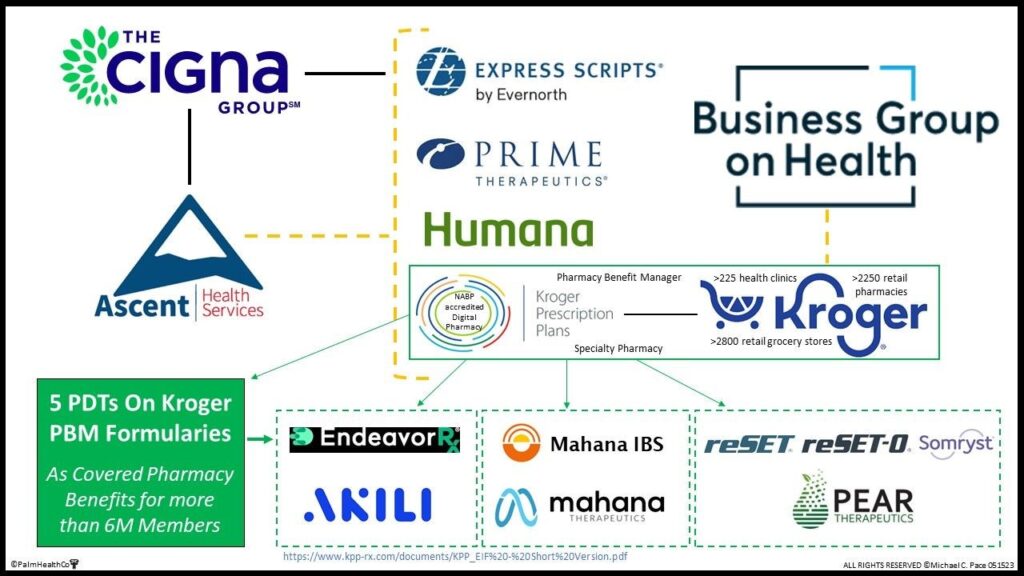“It seemed like an odd pairing: shampoo and a throat swab,” observes a new report on the growth of retail health from Definitive Healthcare.
But retail clinics are no longer, as the paper explains, “an experiment of a few grocery stores….they’re becoming a major force in the U.S. healthcare system,” asserts the thesis of Retailers in healthcare: A catalyst for provider evolution.

While the use of emergency departments fell by 1% in the past five years, the use of retail clinics expanded by 70%, Definitive Healthcare calculated.
Most retail clinics are owned by large retail chains, illustrated in the first pie-circle chart, dominated by CVS Health’s MinuteClinic (with two-thirds of the market share), Kroger’s brand The Little Clinic *with 12%), and Walgreens’ co-owned Village Medical (comprising 8% of the retail clinic share).

“Why are big retailers jumping into healthcare?” the report asks and answers: because they are filling consumers’ demand for more cost-effective care and transparent and fixed pricing. As patients continue to morph into health consumers, facing rising out-of-pocket costs for deductibles and coinsurance shares, people are healthcare payers alongside their employers and government sponsors for insurance.
The second chart graphs average charge per claim for common retail clinic diagnoses, connecting the dots between site-of-care and lower costs in retail clinics compared with hospital outpatient departments, doctor’s offices, and urgent care centers which are higher-cost than retail clinics. For the 10 top diagnoses served in retail clinics, the average charge per claim overall was $38 less than claims submitted through urgent care, $471 lower than claims through physician offices, and $746 less than claims submitted by hospitals.

For context, check out the third chart I’m sharing here from a recent survey into U.S. consumers views on health care costs, conducted in May 2022 for Consumers for Quality Care. This coalition of patient advocacy organizations includes AIDS United, the Allergy & Asthma Network, the American Kidney Fund, Autism Speaks, Black Women’s Health Imperative, the Crohn’s & Colitis Foundation, the Global Liver Institute, National Consumers’ League, and many other patient-driven coalitions.
One-half of U.S. adults have delayed needed care because they could not afford the out-of-pocket costs involved. Three in five believed that an illness or medical emergency in their family would force them into bankruptcy. For people in financially unstable households, those proportions are higher.

Health Populi’s Hot Points: “For pharmacies like CVS and Walgreens,” the report notes, “investing in clinics is also a way to boost prescription drug sales.”
Here, we’re talking beyond channeling antibiotics but expanding services for chronic disease management and population health programs.
Hats off to my colleague Michael Pace of PalmHealth.co for identifying the PBM with the greatest number of FDA-authorized prescription digital therapeutics (PDTs) on formulary was Kroger Prescription Plans, covering 5 PDTs on its preferred drug list. Michael shared the chart shown here in his detailed LinkedIn post discussing this important finding. In his words: “America’s Largest Supermarket Chain Covers More PDTs On Formulary Than Any Other Organization in the U.S.”
Retail health care will continue to evolve in ways that bring products and services closer to people who will mindfully choose more convenient hours, hassle-free (or low-hassle) appointments, convenient locations, and to be sure — lower costs.
About one-in-four consumers Definitive Healthcare identified lacked a usual source of health care, which is an opportunity for the channel to address chronic care management underpinned by technology that both tracks the patient’s progress as well as arms the patient with consumer-facing digital health apps and tools to help them manage care remotely and on-the-go. This opportunity can expand modern care access to under-served people by imagining and designing novel business models to meet that challenge.





 I am so grateful to Tom Lawry for asking me to pen the foreword for his book, Health Care Nation,
I am so grateful to Tom Lawry for asking me to pen the foreword for his book, Health Care Nation,  Thanks to Feedspot for naming this blog, Health Populi, as a
Thanks to Feedspot for naming this blog, Health Populi, as a